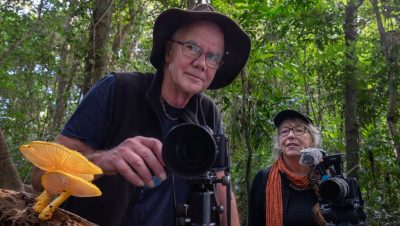Our co-President Rosemary welcomed 78 members to the meeting including several new members. Adelina, our other co-President, asked our members to prepare their stories about how they came to gardening for next month’s meeting.
We had many beautiful specimens presented by our talented members for the flora of the month segment of our meeting.
- Stephen Wedd – Double Gerbera – bigger flower, but maybe not as reliable as the single version.
- Carol Lea – Chrysanthemum – disbud type. Remove small side buds to promote single taller stem. Stokes Aster, Stokesia laevis, a pretty blue flowering perennial from SE USA.
- Fay Bogg – three different flower colours – white, pink, apricot of Mussaenda erythrophylla, Red Flag Bush from West Africa.
- Adelina Linardon – Oriental Evergreen Hydrangea, Dichroa veriscolour syn Dichroa febri rugosa. An evergreen Hydrangea with large dark blue flowers or pink flowers, depending on your soil PH. Hence the name ‘Versicolour’. From the Himalayas, Nepal. Japanese Wind Flower, Eriocapitella hupehensis. Chrysanthemum – disbud type. For cut flowers plant 60cm apart.
Margaret and Diana outdid themselves with this month’s Guest Speakers. Stephen Axford and Catherine Marciniak. Stephen a photographer and time lapse photographer of fungi and Catherine a documentary maker. His time lapse photography has been used in documentaries including David Attenborough’s for the BBC. Stephen explained that fungi are a whole kingdom of life and that new discoveries were being made about how important fungi are. We were shown mesmerising photos and videos of fungi of many:
- Types – Stinkhorn, bracket and puffballs
- Shapes included gills under the cap with stem, cup, funnel and coral shapes.
- Colours of fungi included purple, green, blue, yellow and some are luminous.
He explained the structure of fungi and how they are important in the breaking down and recycling of organic matter and the symbiosis where the fungi dissolves minerals from the soil and makes them available to plants in exchange for sugars, parasitic fungi which use for example ants to spread spores. Stephen explained that a lichen is not a single organism. It is a symbiosis between different organisms – a fungus and an alga or cyanobacterium. Slime moulds are classified as Protista (or Protocista). They are neither plants, animals nor fungi. Slime moulds are peculiar protists that normally take the form of amoeba but also develop fruit bodies that release spores, and are superficially similar to the sporangia of fungi. Slime moulds have a memory. Stephen and Catherine have been invited to document fungi in Yunnan, China, Nepal, Myanmar, India and Sri Lanka. They are in the process of making a documentary called ‘Follow the Rain’ for which they are seeking the final push to complete the crowd funding. https://www.planetfungi.movie/ Crowdfunding website https://bit.ly/GoFundMeFollowTheRain
Afternoon tea was very welcomed and there was a buzz of excitement after a very good and interesting presentation. Our Guest Speaker team are exceptional.
